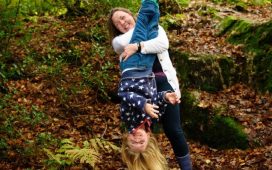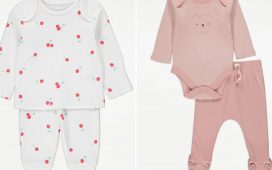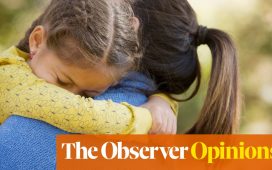When Margaret Reynolds was in her mid-40s, she was a successful writer, academic and broadcaster. One winter’s morning, she asked herself what she would like in her life that she did not already have. The answer was clear and quick: she realised she’d like to have a child. She wanted to be a mother. She was single and had just gone through an early menopause. She decided she would adopt, but this proved to be a long, sometimes difficult journey during which she found herself asking big, far-reaching questions about identity and nationality; about what it means to belong, and what it means to be a parent and a child.
Now, 12 years later, Reynolds, who goes by Peggy, and her daughter Lucy are talking to me over Zoom from their cottage in the Cotswolds, the paws of their dog clacking on the floor in the background. Lucy is 18, articulate and passionate about the adoption system and what the role of the child should be within that process. She had recently been on her gap year – “‘gap’ being the operative word,” says Peggy, laughing – in London, volunteering for a charity called Body & Soul. “They work with children who have had adverse childhood experiences, including adoption, so it’s very on theme,” Lucy says. She is spending the third lockdown back at home.
Peggy adopted Lucy when she was six and, from the beginning, she would write down things that had happened each day with the idea that she might eventually turn the notes into a book. “The thing that galvanised me was, I heard a story of a couple who decided to adopt, went down that road, and got really, really close, and at the last minute, utterly freaked out and couldn’t do it,” Peggy says. She was struck by the strength of her reaction to the case, how sad she was for the child. “The child’s perspective in this was the thing that really hit me as being very painful,” she says. “I was angry.” She told Lucy that she would like to work up her notes. “And that’s what I started to do.”
These notes grew into a beautiful, literary memoir, The Wild Track, which tells an adoption story less traditional than some: Peggy adopted when she was in her 50s, and single, and Lucy was an older child. (In 2020, the average age at which a child is adopted in the UK was three.)
Though Peggy made the decision to adopt quickly, it was still an arduous and lengthy process, and it took roughly seven years until she was matched with Lucy. There were dead ends and wrong turns, including an early attempt to adopt from China, when Peggy made what she now refers to as “my mistake”. She omitted to mention a relationship with a woman that had lasted 11 years. The China Center of Adoption Affairs does not allow foreign adoptions by same-sex couples and though Peggy was no longer in the relationship, when her “non-disclosure” was discovered, the previously granted approval was revoked. Eventually, she pursued a domestic adoption.
There are, says Peggy, two kinds of adoption stories out in the world. One concerns adoptive parents: “What they go through and how they get there. The story ends when the child arrives in their home and that’s it.” The other is about the adopted child as an adult, “Where a grown-up person goes and looks for their birth family.” Though The Wild Track has aspects of both, it offers another perspective: the story of an older mother and an older child – and their growing together.
While their story is hopeful, the pair are careful not to gloss over the difficulties they’ve faced, and they write, together, about problems with candour. When Lucy first came to live with Peggy, for example, the first day and night were tough and distressing. Was it important to ensure the account was as honest as possible? Peggy says that Lucy, in particular, felt that strongly. “We wanted to do children in care and kids who have been adopted justice,” says Lucy. “If it had just been completely positive, a lot of people who have actually experienced that would have looked at it and thought, ‘Well, I must be an anomaly, then.’”
During her application to adopt, Peggy gradually comes to realise that the fulfilment of her greatest desire, to become a mother, is predicated on a child’s pain and loss: “My happiness is her sadness.” This is hard to hear, Peggy says. “That’s a tough thing to say to adoptive parents and prospective adoptive parents, but on the other hand, it’s honest.”
She turns to Lucy.
“It’s recognising certainly what you feel to be the truth of your experience,” Peggy says.
Lucy agrees. “I think a lot of adoptive parents can forget sometimes that their child has been through so much and that things won’t always be happy,” she says. “It doesn’t mean that your relationship with a child is any less strong, it doesn’t mean that there’s any less love. It just means that it’s something to think about.”
Rates of adoption in the UK are down more than a third since 2015, while the number of children being taken into care is on the rise. At the end of March last year, there were more than 80,000 children being looked after by local authorities, up 2% on the year before; during that year, just 3,440 children were adopted. These figures do not tell a straightforward story – not every child in care would be right for adoption, as some will be returned to their biological families, and they do not yet take any impact of the pandemic into account – . But in December, the charity Adoption UK warned that this decline could lead to more children spending their childhoods in care.
“I asked a social worker what counts as a hard-to-place child and she said, anyone over the age of three. Full stop,” says Peggy, who adds that prospective adopters may be nervous of taking on an older child. “In this country, children who are available for adoption, by definition, have been taken into local authority care for a reason. So they have often suffered neglect or abuse. And I think prospective adopters are frightened, in a way quite rightly, by the consequences of that experience. But that’s not to say that they can’t be helped.”
Lucy adds that people may worry they won’t bond with an older child in the same way they would a baby. “It’s not true. We definitely don’t have a less strong bond because I was older. And we know plenty of people who have adopted older kids, even teenagers, and the love there is just immense.”
Peggy seems to have put her academic background to use in learning how to be a parent. Before she was matched with Lucy, she volunteered with children in care and at a nursery. She taught herself therapeutic practices that are recommended for the care of a child who has experienced trauma.
Did all of that mean she felt prepared, when it came down to it? “I had these routines that I knew should help and work. And I did stick to them quite religiously. Consistency in meal times, and lots and lots of exercise to wear you out, things like that. So yes, in one way. In another way, no, because of course, they are only templates and children are different. And you don’t know what you’re going to get,” she says.
When Peggy signed the papers to adopt Lucy, they had never even met. “But you are very surprising,” she says to her daughter. “No, honestly, you are! I happen to be really fortunate because your personality is incredibly positive. And she was like that, even after everything. She’d come into my room first thing in the morning, and say, ‘What exciting thing is going to happen today then?’ When she was six!”
Both Peggy and Lucy agree the system has changed and improved since Lucy’s adoption 12 years ago; children know far more and have more choices than they did in the past. Recent experiences with social services have been impressive, says Peggy. “But there’s still more that could be done.”
Perhaps that is something Lucy will get involved with. She is applying to go to university next year. “I know that in the future, I really want to help people, whether that’s through politics or through charities, or being a human rights lawyer,” she says.
When Peggy began working on what became The Wild Track, she thought she was writing a book about displaced children in literature, until her own experience started to interrupt it. She returned to that idea and will finish it soon. “But my aspect in that book has changed completely,” Peggy says. “I now realise it’s the child’s voice that I’m most interested in.”
Do they think their experiences can help guide prospective adoptive parents, and inspire them? “I would hope so. If I had a political end, as it were, it was to encourage that, because I can honestly say with my hand on my heart that being Lucy’s mother has been the one thing in my entire life that has brought me more contentment, more deep-rooted happiness than anything else.” She begins to well up. Lucy squirms, affectionately. “And now I’m going to have a little cry,” Peggy continues. “But it’s really true. For all the difficulties, wherever they come from, it’s really important for anybody who thinks that they might be able to do it to know that they can, and to know just how amazingly rewarding it can be.”
The Wild Track: Adopting, Mothering, Belonging by Margaret Reynolds, is published by Doubleday at £16.99. Buy it for £14.78 at guardianbookshop.com
Extract from The Wild Track
We are at my nephew’s first birthday party. Another mother – one of my brother’s friends – is contending with her toddler. ‘Mum! Mum! Can I have a biscuit?’ ‘Yes, Maya, darling, but eat two more tomatoes first, please. And what was the word?’ ‘Please!’ The child stomps out before running off.
The place is crawling with babies. The place is crawling with crawling babies. I am sitting on the sofa with my mother and trying to pay attention as she tells me about two DVDs that interest her about China and Tibet. I am vaguely thinking that I must get on the internet and see if I can find them for her. At the same time I am lending half an ear to Stephanie, my American sister-in-law, explaining about Obama’s inauguration: ‘I just decided I had to go. My friends told me where to park and I had to walk for three hours [Is that really what she said?] to get anywhere close to Capitol Hill, but I had a great view, even though we were packed in like sardines.’ She does an imitation, raising her shoulders up to her ears. ‘And we had to squeeze sideways if anyone wanted to go in or out.’
Then I hear: ‘Mummm! Mum!’ I mutter an apology to my own mother and head towards the stairs to the basement. She meets me halfway up, tears on her cheeks, hand outstretched.
‘What is it, darling?’
‘I shut my hand in the door…’
‘OK, honey, come on.’
I scoop her up and take her back to the sofa. My mother says, ‘Let Gran have a look. Oh, it’s not so bad. I’ll rub it for you. How’s that? Better now?’
The point about this story is that I heard her. A lot of the time in those early days, I found myself worrying about not quite being able to spot her in a crowd of other little fair-haired children. But her voice, in whatever crowded circumstance, called to me instantly, particularly, distinguishably, umbilically.
The snow falls. Snow on snow on snow. I get her to school, but the secretary calls two hours later to say that they are closing. A neighbour comes by with a plastic sledge, so we take it up to the hill behind the church. Quite soon I realise just how brilliant this is for a parent. That is, you stand at the top of the slope and admire the view, while the child whizzes down with squeals of delight, then trudges back up again, glowing and energetic. She’ll be worn out in no time. I just wish I’d thought to bring a hip flask.
That night, as she falls asleep, weary beyond measure, she says, ‘Mum, I’ve just had the best day in my whole wide life.’
Her whole wide life. She is six and a half.
At the second review I let her fill in the form by herself. There are questions about her home, what she does with her days and who she sees, and scores about how happy she is. (I steal a glance and discover she marks 10 out of 10. Phew.)
When she gets to a section headed (unhelpfully), ‘What else do you need to move on?’ she writes, ‘Learn to canter.’ At another question labelled (similarly unhelpfully), ‘Is there anything else you would like to see?’ she writes, ‘Dolphins, sharks, giant elves.’
That’s my girl!
At the end of the summer we went to visit friends, Helen and David, in Perthshire. My daughter spent the journey becoming acquainted with a dog on the train, so the hours passed swiftly.
Once arrived, we gathered with other friends round the fire. It might have been late August but it was Scotland. My daughter casually remarked that this was ‘our anniversary’. It was a whole year, to the day, since that frightful time when she had first come to live with me.
David stood up and left the room. A moment later he reappeared with a bottle of champagne and a tray of glasses, including one the size of a thimble for my daughter: ‘This calls for a celebration.’
A short while later she was in her pyjamas and ready for bed, a velvet-covered hot-water bottle supplied by Helen under one arm, Jaffa under the other. I watched her rearranging the selection of bedtime reading offered by David and considered timings: I had written the words that first began this story – ‘It is hard now to recall when she – if she is a she – came into my life’ – in this house. And that visit, when I wrote those words, took place seven years ago. Which meant that when I first wrote those words my daughter had only just been born.














